 |
CDC’s recommendations focus on the healthcare setting, but some of the information may still be valuable to your organization. We’ve also included a link to CDC’s Ebola website at the end of this article.
Patient placement
- Single patient room (containing a private bathroom) with the door closed
- Facilities should maintain a log of all persons entering the patient’s room
You should consider posting a staff member at the patient’s door to ensure appropriate and consistent use of PPE by all persons entering the patient’s room.
Personal Protective Equipment (PPE)
All persons entering the patient’s room should wear at least:
- Gloves
- Gown (fluid resistant or impermeable)
- Eye protection (goggles or face shield)
- Face mask
Yes, you do have the budget and time to train managers and supervisors with BLR’s 10-Minute HR Trainer®. Try it at no cost or risk. Get details.
Additional PPE might be required in certain situations (e.g., copious amounts of blood, other bodily fluids, vomit, or feces present in the environment), including but not limited to:
- Double-gloving
- Disposable shoe covers
- Leg coverings
Recommended PPE should be worn by the healthcare workers upon entry into patient rooms or care areas. Upon exit from the patient room or care area, PPE should be carefully removed without contaminating one’s eyes, mucous membranes, or clothing with potentially infectious materials (see below), and either:
- Discarded; or
- For reusable PPE—cleaned and disinfected according to the manufacturer’s reprocessing instructions and hospital policies.
Hand hygiene should be performed immediately after removal of PPE.
Train your line managers with BLR’s 10-Minute HR Trainer. There won’t be time for classroom boredom. Try it for free.
The PPE healthcare workers wear while treating an EVD patient must be donned and removed in a specific way. The CDC instructs:
- Gloves: Grasp outside of glove with opposite gloved hand; peel off. Hold removed glove in gloved hand. Slide fingers of ungloved hand under remaining glove at wrist.
- Goggles/Face Shield: To remove, handle by “clean” head band or ear pieces. Place in designated receptacle for reprocessing or in waste container.
- Gown: Unfasten neck and then waist ties. Remove gown using a peeling motion; pull gown from each shoulder toward the same hand.
- Gown will turn inside out. Hold removed gown away from body, roll into a bundle, and discard into waste or linen receptacle.
- Mask or Respirator: Grasp ONLY bottom, then grasp top ties/elastics, and remove. Discard in waste container.
- Hands: Perform hand hygiene immediately after removing all PPE!
At this time, Ebola is not a major workplace health hazard for most workplaces in the United States. Nevertheless, being prepared for any infectious disease event should be a priority for every employer. Preparedness reduces the chances of hysteria—employers and employees will know the activities to undertake to ensure safety.
You can get more guidance from the CDC here: http://www.cdc.gov/vhf/ebola.
